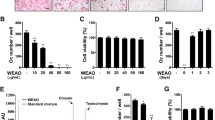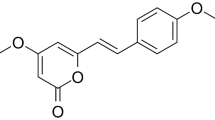Abstract
Osteoporosis is a metabolic disorder that increases the risk of fractures of bone. Receptor activator of nuclear factor-kappa B ligand (RANKL) signaling ultimately activates nuclear factor-activated T cells c1 (NFATc1), a major transcription factor for osteoclast formation. Lichens are symbiotic organisms composed of fungi and algae partners, which are known to be rich repositories of natural metabolites. There was few investigational study on the effect of lichen substances for osteoporosis treatment. This study conducted to elucidate anti-osteoporosis effects of Ramalina litoralis, one of the common saxicolous lichens distributed in the coastal area of Korean Peninsula. In this study, we examined the effects of Ramalina litoralis extract on the osteoclast in osteoporosis. We studied the inhibition of genes and proteins associated with the inhibition of osteoclast by extracts, and the resorptive pit assay for osteoclast function. The extract of Ramalina litoralis reduced the levels of mRNA expression of NFATc1, osteoclast-related receptor (OSCAR), cathepsin K and tartaric acid-resistant phosphatase (TRAP). It also inhibited the translational expression of NFATc1, a major protein in osteoporosis. The inhibitory effect of extracts of Ramalina litoralis on osteoclast differentiation was confirmed using resorptive pit analysis. The extract of Ramalina litoralis inhibited the expression level of NFATcl through the RANKL signaling pathway. This study demonstrates the anti-osteoclastic effect of Ramalina litoralis extract, which can be applied for the effective treatment of osteoporosis, and will serve as an important candidate for making therapeutic agents.
Similar content being viewed by others
References
Boyle, W. J., W. S. Simonet, and D. L. Lacey (2003) Osteoclast differentiation and activation. Nature 423: 337–342.
Baud’huin, M., L. Duplomb, C. Ruiz Velasco, Y. Fortun, D. Heymann, and M. Padrines (2007) Key roles of the OPGRANK–RANKL system in bone oncology. Exp. Rev. Anticancer Ther. 7: 221–232.
Takayanagi, H. (2007) The role of NFAT in osteoclast formation. Ann. N Y Acad. Sci. 1116: 227–237.
Takayanagi, H., S. Kim, T. Koga, H. Nishina, M. Isshiki, H. Yoshida, A. Saiura, M. Isobe, T. Yokochi, J. Inoue, E. F. Wagner, T. W. Mak, T. Kodama, and T. Taniguchi (2002) Induction and activation of the transcription factor NFATc1 (NFAT2) integrate RANKL signaling in terminal differentiation of osteoclasts. Dev. Cell 3: 889–901.
Kono, M., H. Tanabe, Y. Ohmura, Y. Satta, and Y. Terai (2017) Physical contact and carbon transfer between a lichen–forming Trebouxia alga and a novel Alphaproteobacterium. Microbiology 163: 678–691.
Zhou, R., Y. Yang, S. Y. Park, T. T. Nguyen, Y. W. Seo, K. H. Lee, J. H. Lee, K. K. Kim, J. S. Hur, and H. Kim (2017) The lichen secondary metabolite atranorin suppresses lung cancer cell motility and tumorigenesis. Scientific Reports 7: 8136.
Chauhan, R. and J. Abraham (2013) In vitro antimicrobial potential of the lichen Parmotrema sp. extracts against various pathogens. Iran J. Basic Med. Sci. 16: 882–885.
Kim, K. J., M. H. Jung, Y. Lee, S. J. Hwang, H. B. Shin, J. S. Hur, and Y. J. Son (2018) Effect of usnic acid on osteoclastogenic activity. J. Clin. Med. 7: 345.
Feng, X. and J. M. McDonald (2011) Disorders of bone remodeling. Annu. Rev. Pathol. 6: 121–145.
Yin, T. and L. Li (2006) The stem cell niches in bone. J. Clin. Invest. 116: 1195–1201.
Mansour, A., G. Abou–Ezzi, E. Sitnicka, S. E. Jacobsen, A. Wakkach, and C. Blin–Wakkach (2012) Osteoclasts promote the formation of hematopoietic stem cell niches in the bone marrow. J. Exp. Med. 209: 537–549.
Li, J., L. Zeng, J. Xie, Z. Yue, H. Deng, X. Ma, C. Zheng, X. Wu, J. Luo, and M. Liu (2015) Inhibition of Osteoclastogenesis and Bone Resorption in vitro and in vivo by a prenylflavonoid xanthohumol from hops. Sci. Rep. 5: 17605.
Zheng, H., X. Yu, P. Collin–Osdoby, and P. Osdoby (2006) RANKL stimulates inducible nitric–oxide synthase expression and nitric oxide production in developing osteoclasts. An autocrine negative feedback mechanism triggered by RANKL–induced interferon–beta via NF–kappaB that restrains osteoclastogenesis and bone resorption. J. Biol. Chem. 281: 15809–15820.
Matsumoto, M., T. Sudo, M. Maruyama, H. Osada, and M. Tsujimoto (2000) Activation of p38 mitogen–activated protein kinase is crucial in osteoclastogenesis induced by tumor necrosis factor. FEBS Lett. 486: 23–28.
Ikeda, F., R. Nishimura, T. Matsubara, S. Tanaka, J. Inoue, S. V. Reddy, K. Hata, K. Yamashita, T. Hiraga, T. Watanabe, T. Kukita, K. Yoshioka, A. Rao, and T. Yoneda (2004) Critical roles of c–Jun signaling in regulation of NFAT family and RANKL–regulated osteoclast differentiation. J. Clin. Invest. 114: 475–484.
Koga, K., M. Inui, K. Inoue, S. Kim, A. Suematsu, E. Kobayashi, T. Iwata, H. Ohnishi, T. Matozaki, T. Kodama, T. Taniguchi, H. Takayanagi, and T. Takai (2004) Costimulatory signals mediated by the ITAM motif cooperate with RANKL for bone homeostasis. Nature 428: 758–763.
Hofbauer, L. C. and M. Schoppet (2004) Clinical implications of the osteoprotegerin/ RANKL/ RANK system for bone and vascular diseases. JAMA 292: 490–495.
Weiss, J. M., J. M. Weiss, A. C. Renkl, C. S. Maier, M. Kimmig, L. Liaw, T. Ahrens, S. Kon, M. Maeda, H. Hotta, T. Uede, and J. C. Simon (2001) Osteopontin is involved in the initiation of cutaneous contact hypersensitivity by inducing Langerhans and dendritic cell migration to lymph nodes. J. Exp. Med. 194: 1219–1229.
Brömme, D. and K. Okamoto (1995) Human cathepsin O2, a novel cysteine protease highly expressed in osteoclastomas and ovary molecular cloning, sequencing and tissue distribution. Biol. Chem. Hoppe Seyler 14: 379–384.
Kafienah, W., D. Brömme, D. J. Buttle, L. J. Croucher, and A. P. Hollander (1998) Human cathepsin K cleaves native type I and II collagens at the N–terminal end of the triple helix. Biochem. J. 14: 727–732.
Boonen, S., E. Rosenberg, F. Claessens, D. Vanderschueren, and S. Papapoulos (2012) Inhibition of cathepsin K for treatment of osteoporosis. Curr. Osteoporos Rep. 14: 73–79.
Sapkota, M., L. Li, H. Choi, W. H. Gerwick, and Y. Soh (2015) Bromo–honaucin A inhibits osteoclastogenic differentiation in RAW 264.7 cells via Akt and ERK signaling pathways. Eur. J. Pharmacol. 769: 100–109.
Otero, J. E., S. Dai, M. A. Alhawagri, I. Darwech, and Y. Abu–Amer (2010) IKKß activation is sufficient for RANK–independent osteoclast differentiation and osteolysis. J. Bone Miner. Res. 25: 1282–1294.
Sheu, T. J., E. M. Schwarz, D. A. Martinez, R. A. O’Keefe, R. N. Rosier, M. J. Zuscik, and J. E. Puzas (2003) A phage display technique identifies a novel regulator of cell differentiation. J. Biol. Chem. 278: 438–443.
Kim, J. H., K. Kim, H. M. Jin, I Song, B. U. Youn, S. H. Lee, Y. Choi, N Kim (2010) Negative feedback control of osteoclast formation through ubiquitin–mediated down–regulation of NFATc1. J. Biol. Chem. 285: 5224–5231.
Author information
Authors and Affiliations
Corresponding authors
Rights and permissions
About this article
Cite this article
Lee, Y., Jeong, MH., Kim, KJ. et al. The Extract of Ramalina litoralis Inhibits Osteoclast Differentiation. Biotechnol Bioproc E 23, 634–640 (2018). https://doi.org/10.1007/s12257-018-0407-1
Received:
Revised:
Accepted:
Published:
Issue Date:
DOI: https://doi.org/10.1007/s12257-018-0407-1




